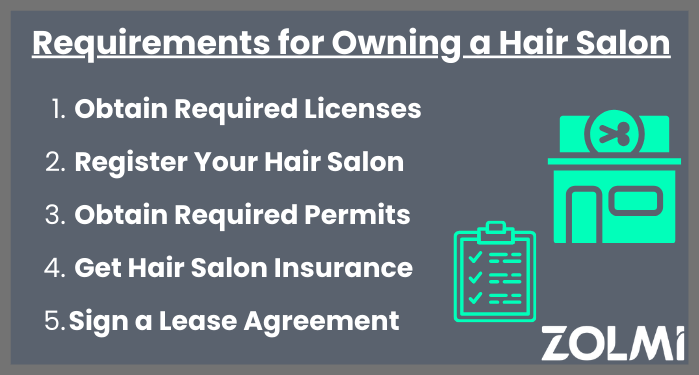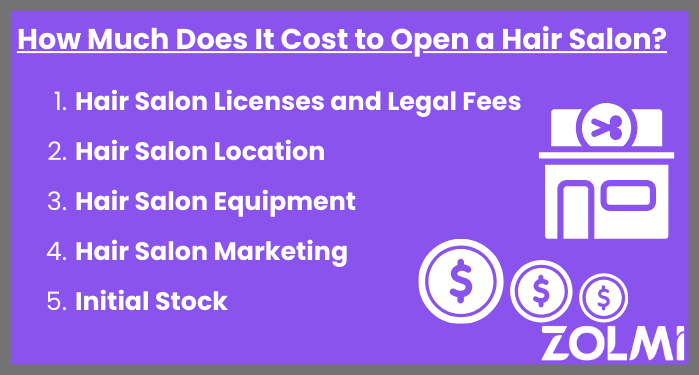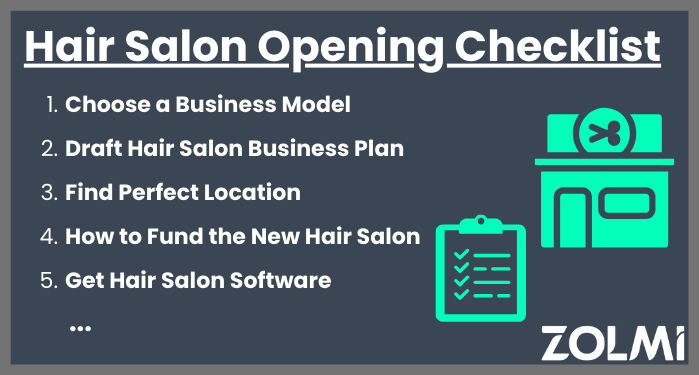How To Open a Salon in 2025 | Complete Guide for Beginners


How to open a salon successfully requires careful planning and dedication, but it can also be an exciting and rewarding journey. Even experienced salon owners understand that starting a new salon involves thorough research and a solid salon business plan. From understanding costs and licensing to investing in the right equipment, staying updated on the latest requirements is essential for success.
In this article, we’ll take a look at the process and requirements of starting a salon business, as well as some salon startup tips, suggestions and some checklists of tasks and equipment for new salon owners.
As a business owner, there are many things you’ll need to prepare when opening a hair salon.
Licenses and permits can vary between states and provinces and sometimes even between municipalities.
Do your research and find out everything you need in your area. Including these when starting a salon checklist and estimating your startup costs is a good idea.
Here’s an overview of the basic business license steps and salon opening requirements to help you get started:
Cosmetologist License: Most places require that you be at least 18 years old and graduate from an accredited cosmetology program or apprenticeship, pass a series of practical exams, and have on-the-job experience performing services on clients to get your cosmetology license.
Salon Business Operation License: The standard business license needed to open your hair salon. You can apply at your state department, or at the U.S. Small Business Administration by providing your name, business name, and social security number.
Certificate of Occupancy: Your local building inspection services or government agency can help you do this. They’ll check to ensure your salon space is safe and verify that it has the necessary water and electrical hookups to operate.
Specific Licences: There are many types of licenses in the beauty industry, some of which might be necessary for your salon staff depending on their area of expertise. If you intend to have a barber or Aesthetician on staff, some states require that they have a separate license for this.
Get your TIN: Also called a Tax Identification Number, you can get this 9-digit number by applying directly to the IRS. Even small business owners who don’t plan to hire any other stylists or staff still need this.
Check Name Requirements: You’ll need a salon name for your new business (more on this later), but some states also have specific requirements for businesses when it comes to names. Make sure to check these when naming your new salon.

Salon Retail Seller Permit: This lets salon owners sell retail products as well as offer services. In states that collect sales tax, you’ll most likely need a retail seller permit. Check the U.S. Small Business Administration or your state’s website for more details.
Building Permits: These permits are handled at the state level and require inspections and approvals for any work that you plan to do to make your hair salon ready for business. Costs can vary, but don’t skip this step- it’s legally required and important for safety.
EIN: You will need your Federal Employer Identification Number to file your Federal and state taxes, salon’s payroll, and other paperwork.
You can get it from the IRS or your state’s online site, and you’ll need to provide your business license, personal information, and a general description of your products and services.
The cost of insurance usually varies between about $50 to $250 a month, and it protects you, your staff, and your salon clients. The most common kind is called “general liability” insurance and protects against damage to your property, claims made against you, or sometimes even damage to your business’s reputation. Do not try to save money on salon insurance!
A lawyer can help you draw this up, although there are templates available online. You’ll want to make sure to have this signed and ready to go before you invest any money in the existing hair salon or make any changes to the physical location. If you’re buying the space, make sure to consult a lawyer to close the sale.
We also recommend you the read of Start Your Own Hair Salon and Day Spa: Your Step-by-Step Guide to Success, by Eileen Figure Sandlin, Entrepreneur magazine
Licenses: In the U.S., these can cost between $100-$400 for small businesses like hair salons. This includes the processing fees and the license itself.
Certificates: The inspections required to issue a Certificate of Occupancy vary by state, but you can expect to pay at least $250. If there are any issues that need to be fixed, you’ll have to correct them and have the location inspected again, for another fee.
Cosmetology licenses and certificates are usually required for all of your staff and their training will need to be kept up to date, too. The fee to renew these varies by state but is often $50 or more.
Permits: Retail requirements will vary by state, but are often a requirement if you plan on selling products to customers. In California, for example, there is no charge for a retail seller permit, but a security deposit may be required.
Legal Fees: A lawyer can help you review your lease or bill of sale, check that all of your paperwork is filed correctly and read any “fine print” on your state’s requirements or insurance paperwork. They usually charge about $200 per hour for their services.
Rent deposit: This will include your first month’s rent, but can also include an additional deposit in some instances (if the property is furnished, some states allow landlords to charge more).You have to choose salon location that will fit best your needs.
Salon Fit-out: The cost of fitting out the hair salon you want will vary a lot depending on your taste, budget and the square footage of the location itself. Don’t be afraid to shop around and get multiple quotes.
Furniture: To start, you can expect to pay anywhere from $200 to more than $1000 for a high-end chair, and washbasins also start at a couple hundred dollars each. Don’t forget furniture for your client reception areas and salon’s break rooms, too.
Signage: It’s important to have the right salon sign in order to attract customers to your new business. That said, a professionally-made sign done by a graphic designer can start at several hundred dollars, so it’s a good idea to shop around before deciding on one.
How much does hair salon equipment cost?
You can buy or lease equipment for your own salon. Both have their advantages and disadvantages.
A complete new set of hair salon equipment and tools will cost you around $27,000, whereas with leasing you make monthly payments. These rates will depend on the company, and many do give you the option to buy the equipment or lease new items later on.
Many companies will offer you the option to lease larger, more costly items such as styling chairs, hood dryers and backwash station chairs, but be prepared to shop around for smaller items such as carts, trolleys and service accessories.
When you start stocking up, keep in mind that your salon’s needs may change in the future, so you’ll want to plan not only what you buy now, but what you may need later.
Your hair salon website is one of your salon’s most important marketing tools, especially if your target market is younger or professional. They tend to value the convenience of online booking and use social media to find the services they’re looking for.
You can create your salon website using a free template online, or hire a professional to help. They usually charge between $300- $700 for this service. Or, you can invest in good salon management software that includes a website building feature.
Don’t forget about business cards and flyers, too. Make sure to reach out to the local community using printed materials that you can distribute at your salon as well as at local businesses.
You may even want to invest in an ad on the radio or in the local newspapers.
To learn more how to make your salon unique please see our post on Salon Marketing Ideas.

Your total stock will vary depending on the size and staffing needs of your salon. When you calculate product needs, make sure to also include disposable items that are used in each service, along with retail products and professional supplies.
Professional Products: These are your “back bar”: what your stylists will use on clients, and should be inventoried separately from sellable stock. Salon software can help you keep track of these.
Retail Products: Track what you sell to clients separately from your supplies budget. How much money you spend on these products will depend on your marketing and the products you choose, as well as any specialities your salon offers (such as shampoos and conditioners for curly hair or treatments for greying hair, for example).
If you want to know more: Marketing plan for a hair salon Ylimartimo, Iida; Lehtinen, Jenna (2019).
Many people wonder how to start a hair salon. Just like with any new business venture, a bit of planning goes a long way. Here are the steps that you can follow to help turn your dream into a profitable business.
Will you join a franchise (this comes with a lot of support, but less independence), or will you run your own business? Also, you’ll need to decide whether to pay your team on commission or rent booths/ space to independent stylists.
If you would like to know more, check out our post on Salon Goals and Objectives.
This helps new hair salons to stay on budget and will give you a roadmap to create your business. Include a marketing plan, your target market, budget, and the kinds of products/ services you’ll offer clients. Add to this a breakdown of your basic recurring salon expenses like staff salaries, insurance, back bar and marketing.
This will depend a lot on your brand and target market. Will your client base be young and professional? Then look for something near a local downtown or business hub. Other salons might do well in cozy neighbourhoods or small towns if this fits their customers and brand.
Not enough cash at startup is one key reason that salons fail, according to the U.S. Small Business Administration. Try to have at least six months in reserve. Sources of funding can include your own savings, help from friends and family, your local credit union, and loans and grants for industry startups. Make sure that you have a budget and plan to pay it back, too.
Your brand helps define your business and clientele. It includes everything from your logo and name to your website and interior design. Pinterest is a great source of ideas to get started. Choose some images and words that define your brand and use them for inspiration.

Set up your website and social media pages, choose a logo, and reach out to the community. Your friends and family can be invaluable when it comes to forming these connections with new clients.
Make sure that you also set up your Google My Business account information with photos so that clients can find you on opening day and leave reviews afterward. Salon software will make following up with them and controlling review content easier, too.
This will help you optimize your salon calendar, enable easy online booking, manage your staff schedule, take payments, track and manage salon inventory, and more, saving you hours of stress and money every week.
Different companies offer different equipment and rates, including simple app-based systems or more complex machines with receipt printing. Don’t be afraid to shop around.
We recommend you learn more from our post on Credit Card Processing for Salons.
Advertise any openings and choose your dream team, then plan your training. If you want to learn more about recruitment check out our guide on How to Hire a Stylist.
This depends a lot on your branding and clientele, so choose a range that compliments your services and vision.
We’ve prepared an opening a salon checklist pdf to help you get started.
Read more about starting a hair salon in Salon Opening: Managed Hair written by Cameron Pine.
This includes everything from furniture to the tools and technology that your team will need. Start by making a list of the big and small items that your space should have, separating “needs” from “wants” in order to stay on budget.
Remember, the equipment can usually be leased or bought, but tools and furniture will probably have to be purchased.
Your salon shopping list should include:
Furniture: Reception desks, chairs, waiting area furniture, backwash stations, salon chairs, product display stands, lighting, wall art, trolleys, and shelving are all necessary items to put on this list.
Electrical Items: These are the blow dryers, drying hoods, curlers, clippers, heat lamps, washing machines, and any specialty items for other services.
Tools and Supplies: This includes disposable items like curling papers and gloves, as well as reusable combs, brushes, scissors, spray bottles, towels, mirrors, and aprons.
Management: Computers/ Laptops for running the salon, salon software to track scheduling, appointments, inventory, POS system, a cash register, and phones are all necessary for the business.
Safety: Fire extinguishers, masks, first aid kits, and hand sanitizer should all be kept on hand.
We’ve prepared an opening a salon equipment list pdf to help you get started.
Are hairs salons profitable? They certainly can be, but operating a successful salon takes a lot of hard work and dedication, too.
While there are a lot of advantages to owning your own hair salon business, there are also some disadvantages that you’ll need to be ready for.
Independence: You make the decisions to guide your business, set your own schedule and keep the profits.
Creative Freedom: Developing your dream business, learning managerial skills and helping to nurture and mentor your team is both rewarding and a great learning experience.
Opportunity: An average salon can generate an income of about 100,000 Euros annually. Out of this about 50,000 Euros is profit for the salon owner. If you manage things well, this can add up.
Administration: From tracking payroll and inventory to updating salon's social media strategy and preparing for tax season, it’s difficult to take on all the administration work. Salon software can help you stay organized, optimize your calendar and deal with scheduling and inventory, but you’ll still have a lot of responsibilities.
Taxes and Legal Necessities: You’ll be the one ultimately responsible for paying taxes, insurance and making sure all your inspections and paperwork are up to date.
Losses: Even the best businesses might have their slower days, and you will need to be prepared for this in your own salon. It’d be your responsibility to see that staff are paid and expenses are met, even if profits are temporarily low.
Opening a salon is a big step, but it can also be gratifying. The most important thing that you can do is invest your time and effort in staying organized right from the start.
Tools like salon software can help with this, and you must prepare yourself by researching and getting your checklists ready before you start making any purchases or investing any money.
The right planning, a clear budget, and a solid marketing strategy can make all the difference when opening a salon.
The financing of business start-ups
https://www.sciencedirect.com/science/article/pii/S08839026
Factors influencing small business start‐ups: a comparison with previous research
https://www.emerald.com/insight/content/doi/10.1108/13l
Small business start‐ups: success factors and support implications
https://www.emerald.com/insight/content/doi/10.1108/13552